Newsletter
Weibo Watch: The Paris Syndrome
Post-pandemic travel disillusionment to the ‘Unkillable One from Shijiazhuang’, an overview of noteworthy and trending topics on Weibo and beyond.
Published
2 years agoon

PREMIUM NEWSLETTER | ISSUE #11
This week’s newsletter:
◼︎ 1. Editor’s Note – The Paris Syndrome hits close to home
◼︎ 2. What’s Trending – A closer look at the featured stories
◼︎ 3. What to Know – Highlighting 8 hot topics
◼︎ 4. What Lies Behind – Raincheck for next week!
◼︎ 5. What’s Noteworthy – Rumored fall of Zhongzhi Enterprise
◼︎ 6. What’s Popular – How the TFBoys boosted Xi’an economy
◼︎ 7. What’s Memorable – Looking back: Swedish Chinese tourist gate
◼︎ 8. Weibo Word of the Week – “The Unkillable One from Shijiazhuang”
Dear Reader,
Half a year after China reopened its borders and around four months after resuming the issuance of tourist visas, there is much discussion surrounding the low number of foreign tourists traveling to China. The proportion of tourists from Europe, the U.S., Japan, and South Korea has significantly dropped.
As more incentives are introduced that might attract more inbound international visitors, such as making it easier for some foreigners to obtain visas upon arrival and letting travelers link their Visa and Mastercard accounts to Alipay and WeChat Pay, many still argue that there are numerous issues hindering smooth travel in China for foreign visitors. A recent report by Wall Street Journal suggested that visitors are staying away because of deteriorating relations between China and the West, but recent viral Twitter posts also highlighted practical reasons, including troublesome visa processes, challenges with digital payments in a cashless society, the Great Firewall, certain hotels not accepting foreign guests, and difficulties encountered when services require Chinese ID cards.
While closely following these tweets, we’ve also noticed a trend on Chinese social media regarding outbound travel to Europe during the same period. Earlier news reports had already mentioned that Europe is experiencing lower-than-expected bookings from high-spending Chinese travelers, and the anticipated ‘Chinese travel boom’ hasn’t materialized. For most Chinese citizens, traveling abroad has become difficult (securing visa appointments for some destinations is almost like a lottery) and more costly. Simultaneously, domestic tourism has become more popular and attractive than ever before, making Chinese holidays a preferred choice.
Consequently, those travelers who finally reached their destinations in Europe recently might have overcome some considerable obstacles to get there. But a recent surge in Europe-related posts within China’s travel-focused social media sphere indicates that for many Chinese travelers, their European adventures turn out to be quite underwhelming.
The phenomenon known as ‘Paris Syndrome’ describes the sense of extreme disappointment some individuals feel when visiting Paris, finding that the city doesn’t match their expectations due to the reality not aligning with the romanticized scenes from movies. While the term originated in the 1980s, typically applying to Japanese tourists experiencing culture shock in Europe, many recent accounts from Chinese travelers also express disillusionment with their European experiences.
Why? The most frequently mentioned reason is that they view Europe as “messy,” “chaotic,” and deficient in public safety to the point that travelers caution each other against going out at night. Many posts on social media recount incidents of theft in cities such as Paris, Amsterdam, Barcelona, and Rome, leaving individuals feeling helpless when they discover that the police couldn’t provide sufficient assistance. Some have even shared experiences of being robbed twice during a single trip, leaving them fearful and disheartened. As a result, Chinese popular Xiaohongshu app is filled with guides and tips on “how not to get robbed in Europe,” recommending special safety bags, hotel room locks, and additional luggage protection. However, some commenters suggest that the joy of traveling is ruined for them if going to European cities means one must prepare to be vigilant at all times and assume that “thieves are all around.”
Observing frustrated international travelers’ Twitter posts in China and the emotional posts from Chinese travelers in Europe, it seems that many of us are experiencing some form of the ‘Paris Syndrome’ recently. Especially during the Covid years, we built up our hopes about that one big trip we were going to make – surely it was going to be the best trip of a lifetime? But we get pickpocketed, we get denied at hotels, we get lost in translation, and we inescapably get disappointed.
Just recently, atop an ancient Chinese pagoda in Zibo, I shared tea for two with another solo traveler – a young teacher from northern China. As I mentioned being from Europe, he shared his hesitation about going there: “I’ve been hearing how unsafe it is for Chinese recently.” After an enlightening conversation, he confided that I was the first foreigner he had ever spoken to. Later, on another train, I received a message from an old friend in Paris who had seen one of my travel photos. He wrote: “You’re traveling in China all alone now? I’ve been hearing how unsafe it is for foreigners recently.”
An upside amidst the negative travel news regarding both Europe and China is that our expectations are lowered. Perhaps we can avoid the Paris Syndrome by venturing out ourselves and discovering that the rewards of travel are usually more meaningful than the disappointments. Breaking barriers and cultural distances entails getting closer to each other – quite literally. So, I expressed my hope to the young teacher I met in Zibo, that he would still decide to explore Europe. Similarly, I hope that China will be able to welcome more international visitors in the near future.
Read more about Chinese travelers’ experiences in Europe in our latest featured post. Zilan Qian and Ruixin Zhang contributed to this newsletter. If you’re still heading out this summer, I wish you happy, safe travels and meaningful experiences.
Best,
Manya (@manyapan)
What’s Trending
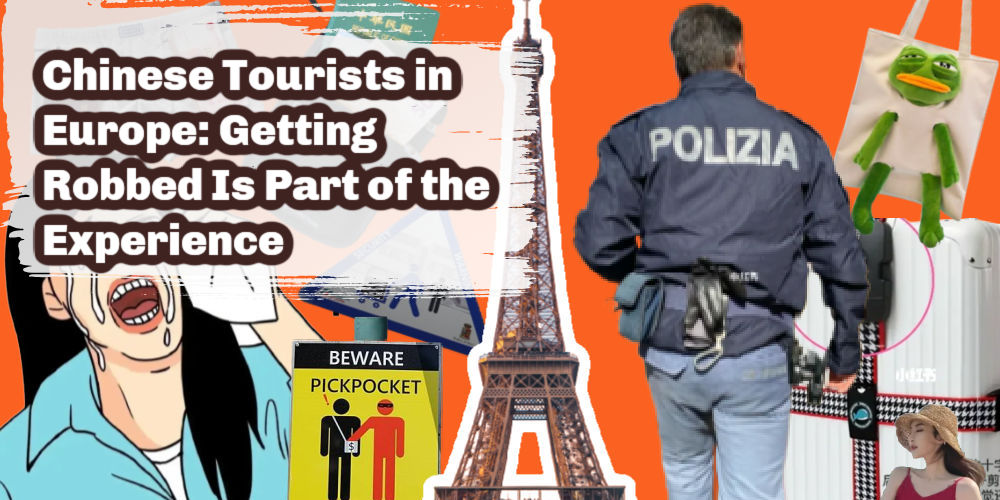
1: Chinese Robbed in Europe | My bag was stolen in Amsterdam, my phone was snatched in Paris, and my camera was robbed in Rome. Chinese social media is brimming with accounts from Chinese travelers sharing their unfortunate experiences of falling prey to theft during their trips to Europe. Getting robbed in Europe has become so common that Chinese apps like Xiaohongshu and Douyin are now flooded with numerous “Europe Anti-Theft Strategies” and “How Not To Get Robbed in Europe” guides.
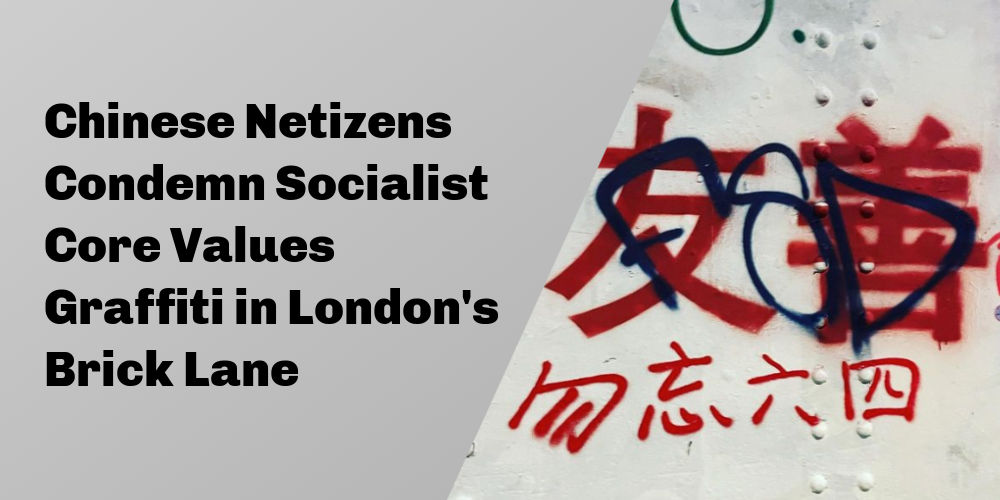
2: Brick Lane Graffiti | In London’s Brick Lane, a wall covered with Chinese slogan graffiti sparked backlash from local art communities and Chinese diaspora recently, with many perceiving the graffiti as a show of support for the Chinese Communist Party. While some voices in China’s social media sphere defended the graffiti, many others condemned the makers for being disrespectiful and arrogant.

3: Milky-Spicy Trend | Some parents think it’s cute, others think it is funny. Dressing children in tight dresses and grown-up attire has evolved into a trend that is mostly visible on Chinese social media. An entire online economy has developed around the ‘Milky-Spicy Trend,’ which is embraced by some parents highlighting its innocence while disregarding potential negative consequences. But recently, Chinese media outlets and social media commenters are pointing out the dangers behind the trend.
What to Know

Haohuanluo noodles have made it to space.
◼︎ 1. China’s among Countries with Lowest Birth Rates. The problem of China’s super low birth rates is not going to solve itself any time soon. A renowned professor of demography, Yuan Xin, made headlines this week for pointing out that China has become one of the countries with the lowest birth rates globally, projecting that China’s negative population growth will continue well into the 2070s. China’s expected number of birth rates for 2023 is 7-8 million, which is another record low. Just 12 million babies were born in 2020 (8.5 births per thousand), 10.6 million babies were born in 2021, and the latest number, published in January 2023, indicated that 9.56 million people were born, while 10.41 million died. 2023 would therefore see the lowest birthrate yet. (Various related trending hashtags on Weibo, one of them being ‘China Now among Countries With Lowest Birth Rates Globally’ #中国已成为全球生育率最低的国家之一#, 200 million views).
◼︎ 2. Xi’an Flash Floods. The village of Weixiping, Xi’an, saw a huge mudslide and flash flood on August 11, triggered by heavy rain. Local authorities set up a major rescue campaign, involving nearly 1000 team members including search & rescue experts and firefighters. According to the latest reports, 21 people died and 6 people are still missing. (Weibo hashtag “21 People Confirmed Dead in Xi’an Mud Slides” #西安泥石流已发现21名遇难者#, 5.8 million clicks; “Still 6 People Passing after Xi’an Landslide #西安泥石流灾害仍有6人失联#, 28+ million clicks).
◼︎ 3. Third Covid Wave. There has been a surge in social media posts this week about Covid infections and a third Covid wave in China. While one after the other posts photos online of their positive tests, one popular comment on Weibo said: “I’ve never had Covid yet, can you believe it?!” (Weibo hashtag “People Testing Postive for Covid for 3rd Time Emerging One by One” #
#新冠三阳的人开始陆续出现##, 450 million clicks)
◼︎ 4. Health Care Corruption Campaign. Recently, China had intensified its crack down on corruption in the health care system, triggering many discussions this week. The campaign, which aims to restore public trust in the medical sector after the pandemic, has already resulted in 168 hospital bosses being nabbed, as reported by South China Morning Post on Sunday. The newspaper further reported that at least two major pharmaceutical firm executives are now under investigation. We’ll report more on this topic as it keeps fermenting online. (Hashtag “Pharmaceutical Representatives Bribing Doctors” #医药代表性贿赂医生#, 520 million views).
◼︎ 5. Hebei Floods Aftermath. The aftermath of the devastating floods in Hebei has remained a prominent topic of discussion this week. For those affected, this might be the most challenging period as some return to find their homes in ruins. As the affected individuals strive to recover, heartening stories on social media showcase people coming together to provide support during this crucial time. For example, those local businesses going the extra mile to supply local schools with new books, or the supermarket in Zhuozhou that’s offering credit for purchases. According to the latest reports, Hebei may need two years to carry out post-flood reconstruction. (Various hashtags).
◼︎ 6. China’s Booming Vehicle Export. This week, reports surfaced that in the first half of 2023, China has overtaken Japan to become the world’s leading vehicle exporter. According to the China Association of Automobile Manufacturers, Chinese auto manufacturers exported 2.34 million vehicles globally from January to June, marking an impressive year-on-year increase of nearly 77 percent. (Various related hashtags, including “China World’s Biggest Exporter of Automobiles in First Half of 2023” #中国半年度汽车出口量居世界第一#, 480,000 views.)
◼︎ 7. Noodle Rocket. Haohuanluo (好欢螺) Snail Noodles, a famous Chinese noodle brand, successfully launched commercial rocket Ceres 1 on August 10 from the Jiuquan Satellite Launch Center in northwestern China’s Gobi Desert, sending seven satellites into planned orbit. Obviously, it was not actually the noodle brand that launched it, but sponsored it, although its social media campaign would make you believe otherwise, with many netizens being surprised that their fav noodle brand made it to space. (Hashtag “Successful Launch of the Haohuanluo Rocket” #好欢螺号火箭发射成功#, 250 million clicks).
◼︎ 8. Return of the Tour Groups. While Chinese tour group trips had already resumed to certain countries in the post-zero-Covid era, China’s Ministry of Tourism made an announcement on August 10th, stating that the resumption of tour groups to additional countries and regions will take place. This now encompasses countries such as Japan and the US, broadening the spectrum of foreign destinations from 60 to 138. The Ministry also reminded outbound tourists to be well-prepared before each journey – which might include checking up on those ‘how not to get robbed in Europe’ guides!
What’s Noteworthy
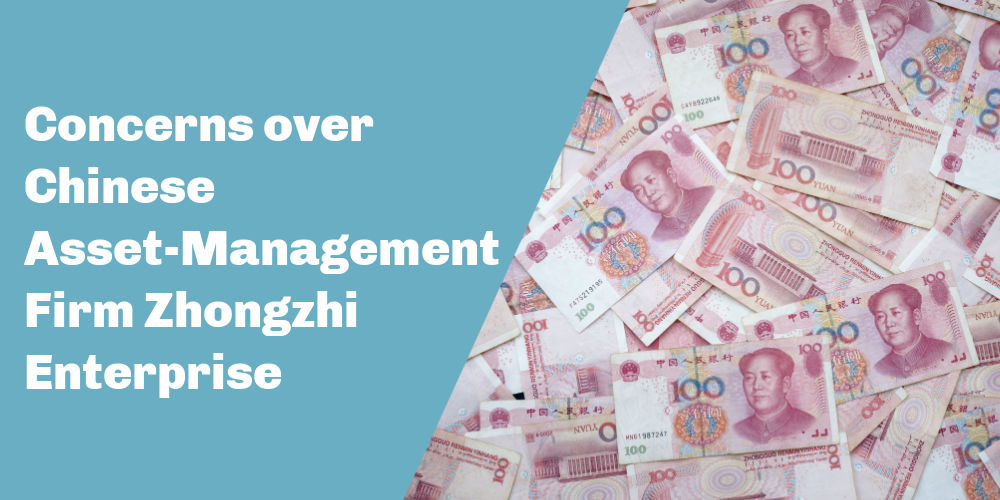
Photo by Eric Prouzet
Rumored Collapse of Zhongzhi Enterprise Group |
Recently, a financial advisor from the third-party wealth management company Hengtian Wealth made a public admission about a potential financial crisis which is said to have unfolded after the Chinese asset management firm Zhongzhi Enterprise Group allegdly failed to meet its loan repayment obligations, affecting around 150,000 individual investors who had collectively invested over 3 million RMB (approximately 416,000 USD). The crisis is estimated to involve a staggering amount of 230 billion RMB (about 32 billion USD), and the largest investment by a single client exceeded 5 billion RMB (approximately 692 million USD).
These rumors sparked concerns in the financial world, triggering strong reactions from both investors and the general public. Meanwhile, the Zhongzhi Group has halted all fundraising and repayment activities. Once a trillion-dollar empire built over decades, the Zhongzhi Group, which controls Zhongrong International and a handful of listed companies, now faces a potential collapse, representing a stunning downfall for a previously respected financial institution.
In response, many netizens have commented with the phrase “poverty spared me from a disaster” (“贫穷使我逃过一劫”), as most investment thresholds start at 3 million RMB (416,000 USD), which they could not afford. While the default might temporarily spare most individuals, some netizens have pointed out that the dynamics playing out among the wealthy could ultimately harm those at the bottom. As of now, there has been no official confirmation from Zhongzhi regarding the widely circulated information. Discussions surrounding this matter on Weibo have been subject to censorship, with numerous netizens reporting instances of their posts being flagged by the company and subsequently removed.
What’s Popular
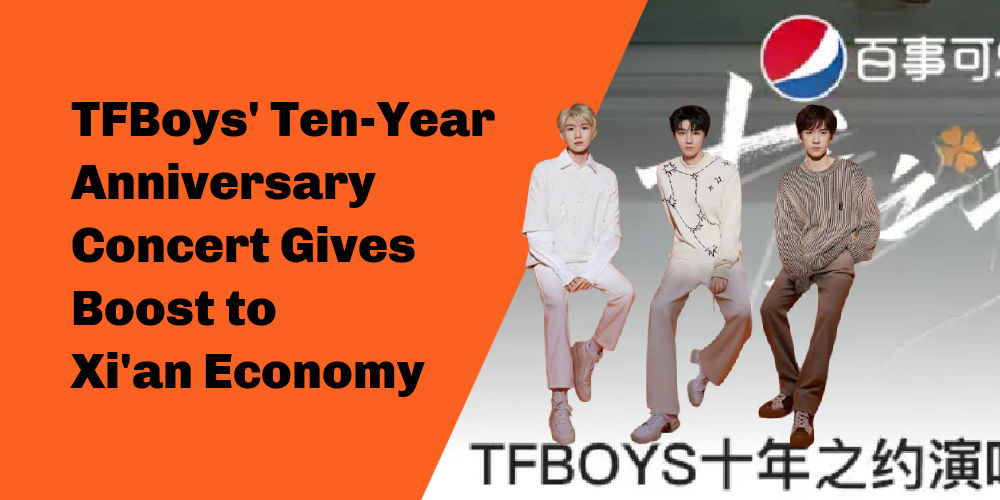
TFBoys Concert Rocks Xi’an | You might remember from our last Weibo Watch newsletter that the immensely popular Chinese pop group, TFBoys, created quite a stir within their fan community when they initially released tickets for their two-hour concert in Xi’an on August 6th, marking the band’s ten-year anniversary and their first live show since 2020.
The event unfolded with a certain degree of chaos and disorder (with reports of fainting fans and overwhelmed security personnel). However, recent news reports suggest that the concert has brought about numerous positive impacts for Xi’an, delivering a significant boost to the local economy. The revenue generated from ticket sales amounted to a staggering 35.76 million yuan (almost 5 million USD), consequently propelling the city’s tourism revenue to an impressive 416 million yuan (57 million USD).
In comparison to the same period in the preceding year, online bookings for accommodations in Xi’an surged by an impressive 738%. Notably, almost half of the TFBoys’ fans not only attended the concert but also took the opportunity to explore some of Xi’an’s scenic attractions. The fact that a single concert can trigger such a significant increase in tourism revenue underscores the triumph of the TFBoys. Debuting as one of China’s pioneering boy bands, the trio’s popularity remains steadfast and impactful.
What’s Memorable
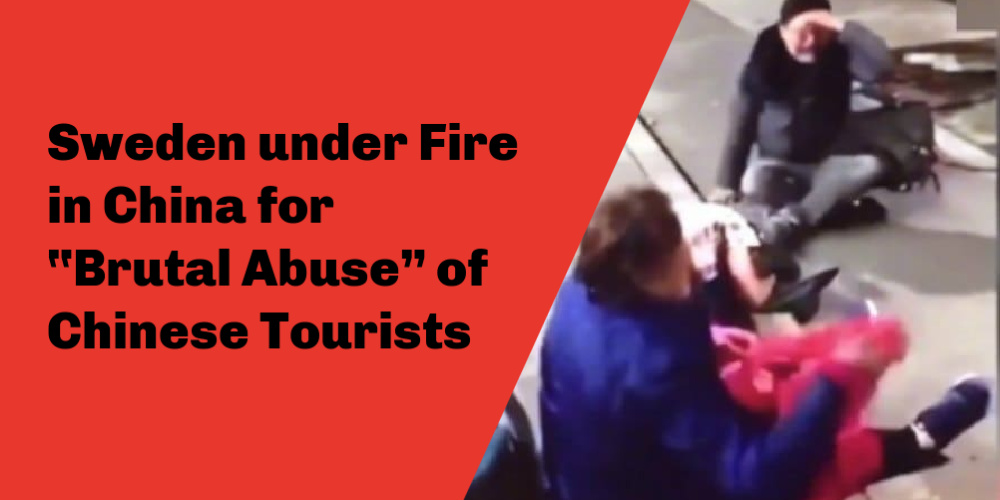
“This is killing!” incident | We already touched upon the ‘Paris Syndrome’ phenomenon in this newsletter, but the Sweden incident took things a step further – we might even liken it to a Stockholm Syndrome if the term weren’t already associated with something else. This incident became one of the most prominent topics on Chinese social media in 2018: the alleged mistreatment of a Chinese family in Stockholm during September ’18 ignited major discussions on Chinese social media, and even led to the Chinese Embassy in Sweden issuing a safety alert for Chinese tourists visiting the country.
The incident made headlines after bystander videos were posted on Chinese social media showing how a Chinese man was dragged out of a hotel by Swedish police, screaming “This is killing, this is killing!” It later showed his family members crying on the street outside of the hotel. Despite the family’s initial assertion of being subjected to severe mistreatment by the hotel without any valid cause, subsequent information revealed that the Chinese tourists had arrived significantly ahead of the designated check-in time and had chosen to remain in the hotel lobby. Nonetheless, this incident escalated to such an extent that it triggered a diplomatic dispute between Sweden and China.
Weibo Word of the Week
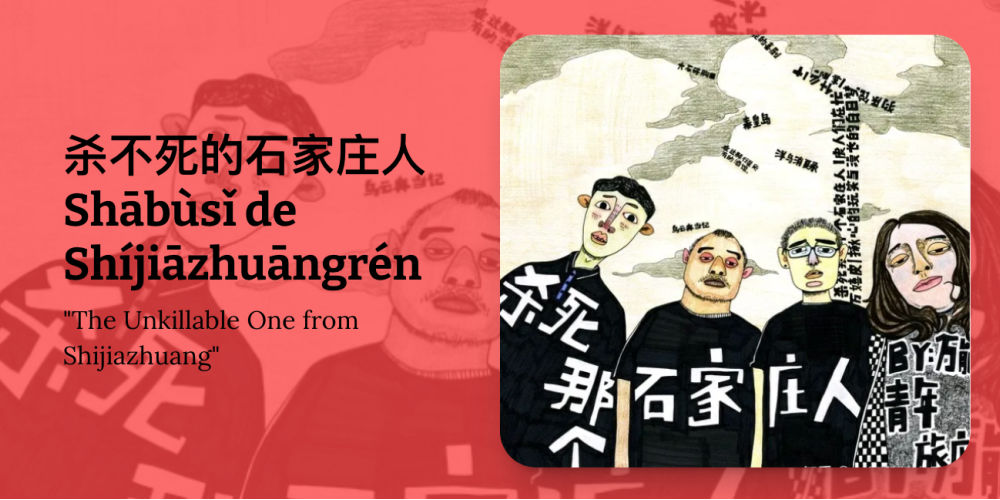
“The Unkillable Shijiazhuang Guy” | Our Weibo Word of the Week is actually a phrase this time, namely 杀不死的石家庄人 (shābùsǐ de Shíjiāzhuāngrén), which translates to “The Unkillable One from Shijiazhuang.” This phrase has gained popularity among netizens recently as a way to express sarcasm.
Shijiazhuang serves as the capital and the most populous city of China’s Hebei Province. “The Unkillable One from Shijiazhuang” (杀不死的石家庄人) is actually a song released in 2022 by the local Hebei Communist Youth League. It serves as a ‘harmonious’ reinterpretation of the renowned 2010 Chinese song “Kill the One from Shijiazhuang” (杀死那个石家庄人) by the Chinese rock band Omnipotent Youth Society. The original song, which delved into the consequences of the planned economy in northern China and the turbulence stemming from widespread job losses, deeply resonated as a shared memory among an entire Chinese generation.
The adapted song title has since been employed by Chinese netizens to express sarcasm, partly poking fun at the Communist Youth League’s attempt to revise a song that once conveyed hardship into one echoing state propaganda. The song’s renewed attention stems from Shijiazhuang’s recent declaration to transform itself into a “Rock N Roll Center,” adopting the slogan “The Unkillable Shijiazhuang.”
This move has been met with an incredulous response from the public, leading to a surge of imaginative adaptations online. These creative reinterpretations humorously reflect individuals’ resilience within a constrained cultural and social environment – a skillful form of self-deprecating expression. As one netizen eloquently summed it up: the previous generation experienced unemployment, the current generation is grappling with it, access to esteemed universities became harder, and now even our city’s anthem has been altered. Despite it all, I continue to reside in Shijiazhuang – this is the true essence of being “the unkillable one from Shijiazhuang!”
This is an on-site version of the Weibo Watch newsletter by What’s on Weibo. Missed last week’s newsletter? Find it here. If you are already subscribed to What’s on Weibo but are not yet receiving this newsletter in your inbox, please contact us directly to let us know.
Stories that are authored by the What's on Weibo Team are the stories that multiple authors contributed to. Please check the names at the end of the articles to see who the authors are.
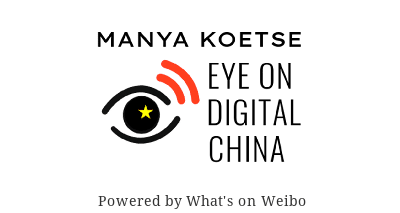
You may like
Dear Reader
Eye on Digital China: How Chinese Social Media Evolved from the Blog Era to the AI-driven Age
A look back at the three major phases of China’s social media — and why What’s on Weibo is evolving into Eye on Digital China.
Published
2 weeks agoon
November 12, 2025
This edition of the Eye on Digital China newsletter by Manya Koetse was sent to premium subscribers. Subscribe now to receive future issues in your inbox.
“Do you still remember going to the internet cafe, paying 2 yuan ($0.30) per hour during the day or 7 yuan ($1) for an all-nighter? Staying up playing games and surfing around?”
It’s the kind of content you’ll often see today on platforms like Douyin or Bilibili — nostalgic videos showing smoky internet cafes (wangba 网吧) from the early 2000s, where people chatted on QQ or played World of Warcraft on old Windows PCs while eating instant noodles. These clips trigger waves of nostalgia, even among internet users too young to remember that era themselves.

Internetcafe in 2005, image via 021zhaopin.com
The current nostalgia wave you see on Chinese social media is indicative of how China’s digital world has evolved over the past 25 years, shifting from one era to the next.
As I welcome a new name for this newsletter and say goodbye to ‘Weibo Watch’— and, in the longer run, to the ‘What’s on Weibo’ title, I’m feeling a bit nostalgic myself. It seems like a good moment to look back at the three major stages of Chinese social media, and at the reason I started What’s on Weibo in the first place.
1. The Blogging Boom (2002–2009): The Early Rise of Chinese Social Media
When I first came to China and became particularly interested in its online environment, it was the final phase of the early era of Chinese social media — a period that followed soon after the country had laid the foundations for its internet revolution. By 1999, the first generation of Chinese internet giants — Alibaba, Tencent, Baidu, and Sina — had already been founded.
China’s blogging era began with the 2002 launch of the platform BlogChina.com (博客中国), followed by a wave of new platforms and online communities, among them Baidu Tieba and Renren. By around 2005, there were roughly 111 million internet users and 16 million bloggers, and the social impact was undeniable. 2005 was even dubbed China’s “year of blogging.” 1
Chinese writer Han Han (韩寒, born 1982), a high-school-dropout-turned–rally car racer, became one of the most-read figures on the Chinese internet with his sharp and witty blogs. He was just one among many who rose to fame during the blog era, becoming the voice of China’s post-1980s youth.

The rebel of China’s blog era, Han Han, became of voice of his generation.
When I moved to Beijing in 2008, I had a friend who was always out of money and practically lived in an internet cafe in the city’s Wudaokou district, not far from where I studied. We would visit him there as if it were his living room — the wangba was a local hangout for many of us.
Not only online forums and blogging sites were flourishing at the time, but there was also instant messaging through QQ (腾讯QQ), online news reading, and gaming. Platforms like the YouTube equivalents Tudou (土豆) and Youku (优酷) were launched, and soon Chinese companies began developing more successful products inspired by American digital platforms, such as Fanfou (饭否), Zuosa (做啥), Jiwai (叽歪), and Taotao (滔滔), creating an online space that was increasingly, and uniquely, Chinese.
That trajectory only accelerated after 2009, when popular Western internet services, including Twitter, Facebook, and YouTube, became inaccessible from within mainland China.
⚡ The launch of Sina Weibo in 2009 came at a crossroads for China’s social media landscape: it was not only a time when many foreign platforms exited China, but also when internet cafes faced major crackdowns.
As a foreigner, I don’t think I ever visited internet bars in Beijing anymore by that point — internet use had largely shifted to home connections. Laptop ownership was rising, and we all had (pre-smartphone) mobile phones, which we used to text each other constantly, since texting was cheaper than calling.

Some of the mobile phones in China’s 2009 top 10 lists.
Weibo came at just the right time. It filled the vacuum left by the online crackdowns across China’s internet while still benefiting from the popularity of blogging. Weibo (微博), after all, literally means “micro-blog” — micro because the number of characters was limited, just like Twitter, making short-form posts the main way of communication.
Weibo quickly became hugely successful, for many more reasons than just timing. Its impact on society was so palpable that its trending discussions often seeped into everyday conversations I had with friends in China.
In English-language media, I kept reading about what was being censored on the Chinese internet, but that wasn’t necessarily what I wanted to know — I also wanted to know what was on Weibo, so I could keep up with my social circles.
That question planted the seed for What’s on Weibo: the simple curiosity of “What are people talking about?” What TV series are popular? What jokes and controversies are everyone discussing (but that I never fully grasped)? I wanted to get a sense of an online world that was, in many ways, intangible to outsiders — including myself. As I had moved back to Europe by then, it was also a way for me to stay connected to those everyday conversations unfolding online in China.
With scissors, glue, and some paper, I started sketching out what a future website might look like.
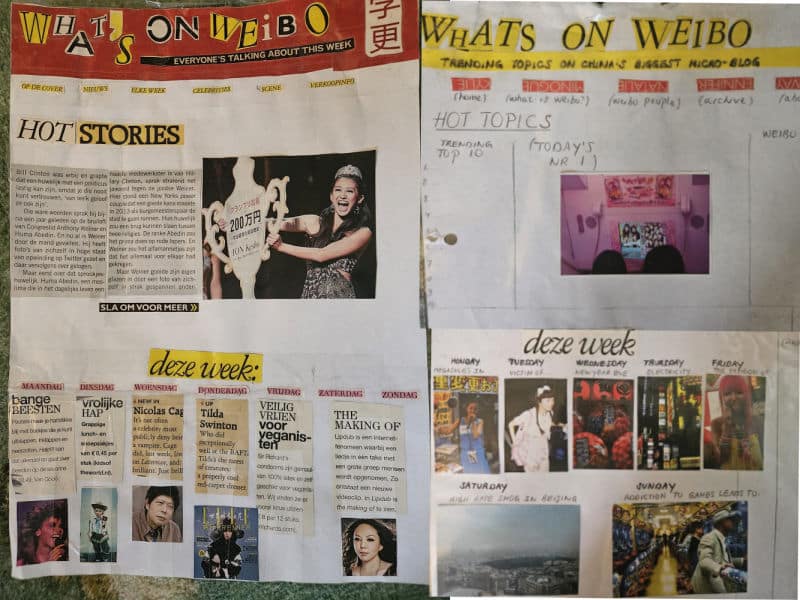
Papercrafting the idea for a website named ‘What’s on Weibo’ in 2012.
And in March 2013, after doing my best to piece it together, I launched What’s on Weibo and began writing — about all kinds of trends, like the milk powder crisis, about China’s many unmarried “leftover men” (shengnan 剩男), and about the word of the moment, “Green Tea Bitch” (lǜchá biǎo 绿茶婊) — a term used to stereotype ambitious women who act sweet and innocent while being seen as calculating or cunning.
2. From Weibo to the Taobao Moment: China’s Mobile Social Era: (2010–2019)
Around 2014–2015, people started saying Weibo was dead. In fact, it hadn’t died at all — some of its most vibrant years were still ahead. It had simply stumbled into the mobile era, along with China’s entire social media landscape.
As mobile internet became more widespread and everyone started using WeChat (launched in 2011), new mobile-first platforms began to emerge.2 In 2012–2013, for example, apps like Toutiao and Xiaohongshu (小红书, RED) were launched as mobile community platforms. With the rapid rise of China’s new tech giants — Bytedance, Meituan, and Didi — a new mobile era was blossoming, leaving the PC-based social media world far behind.
Spending another summer in Beijing in 2014, I called it the “Taobao Moment” — Taobao being China’s most successful online marketplace, a platform for buying and selling practically everything from clothes and furniture to insurance and even Bitcoins. At the time, I thought Taobao captured everything Beijing was at that moment: a world of opportunities, quick decisions, and endless ways to earn and spend money.
On weekends, some of my friends would head to the markets near the Beijing Zoo to buy the latest dresses, purses, jeans, or shoes. They’d buy stock on Saturday, do a photo shoot on Sunday, and sell the goods online by Monday. You could often spot young people on the streets of Beijing staging their own fashion shoots for Taobao — friends posing as models, Canon cameras in hand.
During that period, What’s on Weibo gradually found its audience, as more people became curious about what was happening on Chinese social media.
Around 2016, Weibo entered another prime era as the “celebrity economy” took off and a wave of “super influencers” (超级红人) emerged on the platform. Papi Jiang stood out among them — her humorous videos on everyday social issues made her one of China’s most recognizable online personalities, helping to drive Weibo’s renewed popularity.

Witty Papi Jiang was a breath of fresh air on Weibo in 2016.
People were hooked on social media. Between 2015 and 2018, China entered the age of algorithm- & interest-driven multimedia platforms. The popularity of Kuaishou’s livestreaming and Bytedance’s Douyin signaled the start of an entirely new era.
3. The New Social Era of AI-fication and Diversification (2020–Current)
China’s social media shifts over the past 25 years go hand in hand with broader technological, social, and geopolitical changes. Although this holds true elsewhere too, it’s especially the case in China, where central leadership is deeply involved in how social media should be managed and which direction the country’s digital development should take.
Since the late 2010s, China’s focus on AI has permeated every layer of society. AI-driven recommendation systems have fundamentally changed how Chinese users consume information. Far more than Weibo, platforms like Douyin, Kuaishou, and Xiaohongshu have become popular for using machine-learning algorithms to tailor feeds based on user behavior.
China’s social media boom has put pressure on traditional media outlets, which are now increasingly weaving themselves into social media infrastructure to broaden their impact. This has blurred the line between social media and state media, creating a complex online media ecosystem.
At the same time, it’s not just AI and media convergence that are reshaping China’s online landscape — social relationships now dominate both information flows and influence flows. 3 Not everyone is reading the same headlines anymore; people spend more time within their own interest-based niches. It’s no longer about microblogging but about micro-communities.
China now has 1.12 billion internet users. Among new users, young people (aged 10–19) and the elderly (60+) account for 49% and nearly 21%, respectively. The country’s digital environment has never been more lively, and social media has never been more booming.
As a bit of a dinosaur in China’s social media world, Weibo still stands tall — and its trending topics still matter. But the community that was once at the heart of the Chinese internet has dispersed across other apps, where people now engage in more diverse ways than ever.
In China, I notice this shift: where I once saw the rise of Weibo, the Taobao boom, or the Douyin craze, I now see online and offline media increasingly converging. Social media shapes real-life experiences and vice versa, and AI has become integrated into nearly every part of the media ecosystem — changing how content is made, distributed, consumed, and controlled.
In this changing landscape, the mission of What’s on Weibo — to explain China’s digital culture, media, and social trends, and to build a bridge between Western and Chinese online spaces — has stayed the same. But the name no longer fits that mission.
Over the past few years, my work has naturally evolved from Weibo-focused coverage to exploring China’s digital culture through a broader lens. The analysis and trend updates will continue, but under a new name that better reflects a time when Weibo is no longer at the center of China’s social media world: Eye on Digital China.
For you as a subscriber (subscribe here), this means you can expect more newsletter-based coverage: shorter China Trend Watch editions to keep you up to date with the latest trends, along with other thematic features and ‘Chapter’ deep dives that explore the depth behind fleeting moments.
For now, the main website will remain What’s on Weibo, but it will gradually transition into Eye on Digital China. I’ll keep the full archive alive — more than twelve years of coverage that helps trace the digital patterns we’re still seeing today. After all, the story of China’s past online moments often tells us more about the future than the trends of the day.
Thank you for following along on this new journey.
By Manya Koetse
(follow on X, LinkedIn, or Instagram)
1 Liu, Fengshu. 2011. Urban Youth in China: Modernity, the Internet and the Self. New York: Routledge, 50.
2 Mao Lin (Michael). 2020. “中国互联网25年变迁:两次跃迁,四次浪潮,一次赌未来” [25 Years of China’s Internet: Two Leaps, Four Waves, and a Gamble on the Future]. 人人都是产品经理 (Everyone Is a Product Manager), January 3. https://www.woshipm.com/it/3282708.html.
3 Yang, Shaoli (杨绍丽). 2025. “研判2025!中国社交媒体行业发展历程、重点企业分析及未来前景展望:随着移动互联网兴起,社交媒体开始向移动端转移 [Outlook for 2025! The Development History, Key Enterprises, and Future Prospects of China’s Social Media Industry: With the Rise of Mobile Internet, Social Media Has Shifted to Mobile Platforms].” Zhiyan Consulting (智研咨询), February 7. https://www.chyxx.com/industry/1211618.html.
Spotted a mistake or want to add something? Please let us know in the comments below or email us. First-time commenters, please be patient — we will have to manually approve your comment before it appears.
Eye on Digital China, by Manya Koetse, is co-published on Substack and What’s on Weibo.
Both feature the same new content — so you can read and subscribe wherever you prefer. Substack offers community features, while What’s on Weibo provides full archive access. If you’re already subscribed and want to switch platforms, just get in touch for help. Both feature the same new content — so you can subscribe or read wherever you prefer. If you’re already subscribed on one platform and would like to move your subscription over, just let me know and I’ll help you get set up.
© 2025 Manya Koetse. All rights reserved.
China Media
IShowSpeed in China: Streaming China’s Stories Well
Published
8 months agoon
March 30, 2025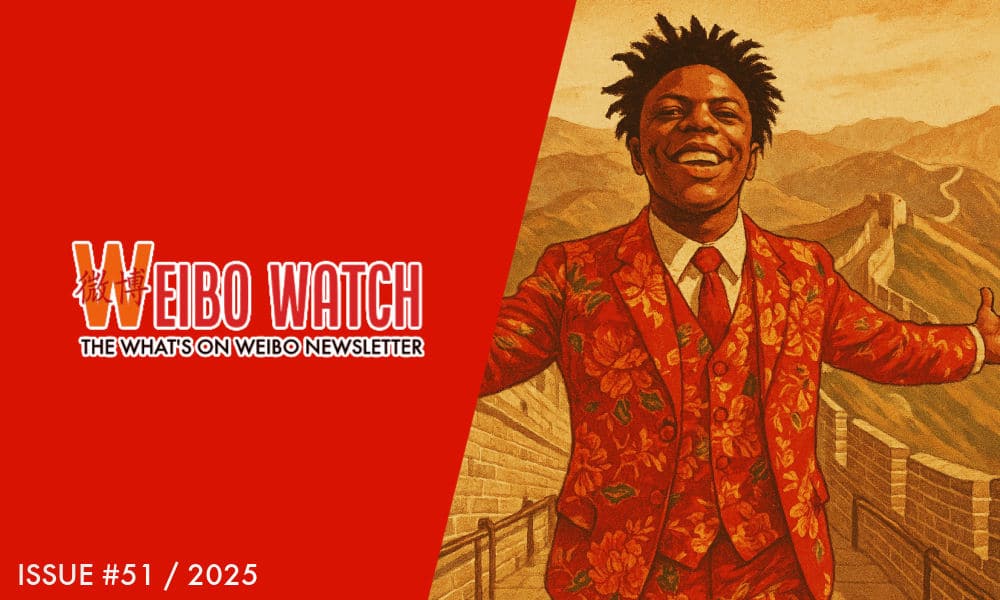
“This man is doing God’s work. In just six hours, he eliminated all Western media propaganda about China,” Chinese influencer Li Sanjin (李三金) said in one of his videos this week. The man he referred to, allegedly doing ‘God’s work,’ is the American YouTuber and online streamer Darren Watkins, better known as IShowSpeed or Speed, who visited China this week and livestreamed from various locations.
With 37 million followers on his YouTube account, Watkins’ visit hasn’t exactly flown under the radar. His streams from China have already accumulated over 17.5 million views on YouTube alone, and he also became the talk of the week on Chinese social media.
In China, the 20-year-old IShowSpeed is known as Jiǎkànggē (甲亢哥), or “Hyper Bro,” since the immensely popular YouTube star is known for being highly energetic.
Although IShowSpeed is originally known for soccer and gaming-related content, he’s been streaming live from various countries over the past year, from Ecuador to Bolivia, from Australia to Indonesia, from Romania to Japan, and also from the Netherlands, where a mob of fans harassed the YouTuber to such an extent that the influencer fled and panicked, until the police intervened and asked him to shut down the livestream for safety reasons — which he did not comply with.
It was not the only time IShowSpeed’s visit got chaotic. He also got into trouble during livestreams from other countries. While streaming from Norway, he injured his ankle and was swarmed by a crowd while trying to get out. In Greece and Indonesia, he had to ask for police support as well. In Thailand, he crashed a tuk-tuk into a temple wall.
In China, IShowSpeed’s livestreams went far more smoothly, and netizens, state media, and other official channels raved about his visit and its favorable portrayal of the country and its culture.
🔹 Symbol of Cultural Exchange & Positive Diplomacy
“Jiǎkànggē” became one of the viral terms of the week, on Weibo, Kuaishou, Douyin, and Toutiao. During his China trip, the livestreamer hit several YouTube milestones — not only breaking the 37 million subscriber mark while on stream, but also surpassing the magic number of 10 million views in total.
Watkins, also known for being (sometimes aggressively) loud and chaotic, suddenly emerged as a symbol of cultural exchange and positive diplomacy. The past week saw hashtags such as:
#️⃣”IShowSpeed gives young foreigners a full-window view into China” (#甲亢哥给国外年轻人开了全景天窗#)
#️⃣”IShowSpeed’s Shanghai livestream breaks Western filter on China” (#甲亢哥上海直播打破西方对中国滤镜#)
#️⃣”American influencer IShowSpeed amazed by stable wifi on China’s high-speed train” (#美国网红甲亢哥被高铁稳定网络震惊#)
#️⃣”IShowSpeed praised deep tried tripe for being incredibly delicious” (#甲亢哥赞爆肚太好吃了#), or
#️⃣ “IShowSpeed bridges the cultural divide” (#甲亢哥弥合文化鸿沟#).
While in Chinese media, Watkins was lauded for shining a positive light on China, this message was also promoted on English-language social media, where he was praised by the Chinese embassy in the US (#驻美大使馆称赞甲亢哥中国行#), writing:
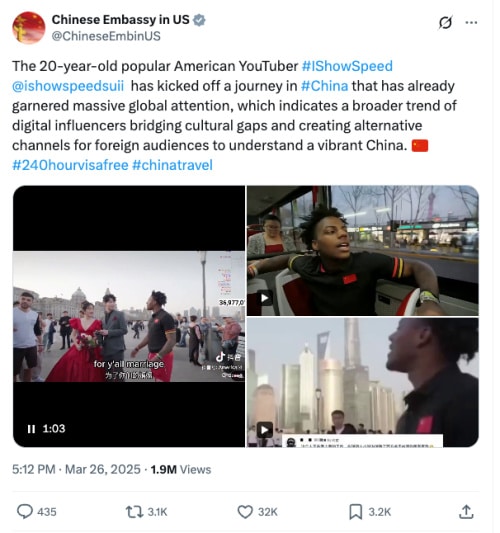
Post by Chinese Embassy in the US on X, March 26.
“This 20-year-old American internet star is bridging cultural gaps through digital means and creating new channels for foreign audiences to better understand China.”
So what exactly did IShowSpeed do while in China?
On March 24, Watkins livestreamed from Shanghai. He wandered around the city center, visited a KFC, danced with fellow streamers, stopped by a marriage market, ate noodles, played ping-pong, had hotpot, joined a dragon dance group and got acquainted with some traditional Chinese opera performance, and walked along the Bund.

On March 26, he streamed from Beijing, starting in Donghuamen before briefly entering the Forbidden City—dressed in a Dongbei-style floral suit. He later took a stroll around Nanluoguxiang and the scenic Houhai lake, rode a train, and finally visited the Great Wall, where he did backflips.

In his stream on March 28, Watkins traveled to Henan to visit the famous Shaolin Temple in Dengfeng, hoping to find a master to teach him kung fu. He trained with Shaolin monks—footage that quickly went viral.
Lastly, on March 29, he opened his own Weibo account and published his first post. On Douyin, he shared a video of his visit to Fuxi Mountain in Zhengzhou, featuring the popular “Stairway to Heaven” tourist spot.
On social media, many viewers were captivated by the content. One major talking point was the remarkably strong internet connection that allowed him to livestream for six-hour stretches without losing signal in Shanghai. (Though his Beijing stream started off patchier, the drop was minor.) For many, it symbolized the quality of China’s 5G services.
Foreign viewers also praised how safe, friendly, and clean the country appeared, and how his streams highlighted various aspects of Chinese culture—from everyday people to traditional arts and local cuisine.
🔹 Telling & Spreading China’s Stories Well
It is no wonder the success of the Jiǎkànggē livestreams is celebrated by Chinese official media in an age where China’s foreign communication aims to increase China’s international discourse power, shaping how the world views China and making that image more credible, more respectable, and more lovable.
That’s not just an observation — it’s an official strategy. Introduced by Xi Jinping in 2013, “Telling China’s Story Well” (“讲好中国故事”) is a political slogan that has become a key propaganda strategy for China and continues to be a priority in finding different ways of promoting Chinese culture — new ways of telling China’s story in the social media age – while countering Western dominant narratives about China.
In increasingly digitalized times, it is not just about telling China’s story well, but also spreading China’s message effectively — preferably through genuine and engaging stories (Cai 2013; Qiushi 2021).
Especially young, non-official ‘storytellers’ can make China’s image more relatable and dynamic. One major example, highlighted in a 2022 case study by Zeng Dan (曾丹), is Chinese influencer Li Ziqi (李子柒). You’ve probably heard of her, or seen snippets of her videos: she creates soothing, cinematic content depicting China’s countryside lifestyle, focused on cooking, crafts, and gardening. With 26 million followers on YouTube, Li Ziqi became a viral sensation who successfully communicated an authentic and appealing ‘China story’ to a broad global audience.

Li Ziqi in one of her YouTube videos.
Although the calm and composed Li Ziqi and the loud, chaotic IShowSpeed couldn’t be more different, they have some things in common: both have large international fanbases, including their millions of YouTube subscribers; they offer perspectives that differ from Chinese state media or official channels; and they have the capacity not just to tell China’s story well, but to spread it effectively through videos and livestreams.
🔹 Spontaneous Stream or Scripted Propaganda?
IShowSpeed’s China streams have triggered a wave of responses from fans and viewers, sparking discussions across international social media and even making newspaper headlines.
In English-language online media spheres, there appear to be a range of perspectives on Watkins’ China trip:
📌 One prominent view—also echoed by various foreign influencers on YouTube and other platforms—is that IShowSpeed’s visit counters “Western media lies” about China and has successfully shown the “real China” through his livestreams. The Shanghai-based media outlet Radii claimed that “IShowSpeed’s China Tour is doing more for Chinese Soft Power than most diplomats ever could.”
📌 Others challenge this narrative, questioning which dominant Western portrayals of China IShowSpeed has actually disproven. Some argue that the idea of China being a “bleak place with nothing to do where people live in misery” is itself a false narrative, and that presenting IShowSpeed’s livestreams as a counter to that is its own form of propaganda (see: Chopsticks and Trains).
📌 There are also those who see Watkins’ trip as a form of scripted propaganda. To what extent were his livestreams planned or orchestrated? That question has become one of the central points of debate surrounding the hype around his visit.
These rumors have been addressed by cameraman Slipz (@shotbyslipz), who took to X on March 28, 2025. Slipz posted that the team is “(..) not making political content, not any documentary and no journalism,” and later added: “Fact: amount of money IShowSpeed has received from Chinese Government = $0.”

But does the fact that IShowSpeed did not receive money from the Chinese government mean that it wasn’t also a form of China promotion?
➡️ Organized — it definitely was. Any media trip in China has to be. IShowSpeed would have needed a visa, he had translators with him, and throughout the streams it’s evident that local guards and public security officers were present, walking alongside and helping to keep things under control, especially in crowded areas and at major tourist spots — from Nanjing Road in Shanghai to an entire group of guards seemingly accompanying the entourage in the Forbidden City.
One logistical “advantage” to his visit was the fact that YouTube is blocked in China. While some Chinese fans do bypass the Great Firewall to access the platform, IShowSpeed remains far less known in China than in many other countries — a factor that likely contributed to how smoothly the streams went and helped prevent chaos. The team also launched a Douyin account during the trip, where he now has over two million followers. (To stream directly to their 37 million followers on YouTube, Watkins’ team either needed a VPN to access WiFi or had arranged roaming SIM cards to stay connected.)
➡️ Was it staged? Many parts clearly weren’t: casual public conversations, spontaneous barber visits in both Shanghai and Beijing (with barbers looking unsure of how to handle the situation), and wholesome fan encounters. There was even a moment when Watkins walked into a public restroom and forgot to mute the sound.
But other parts of the trip were undeniably staged — or at least framed to appear spontaneous. When visiting a marriage market in Shanghai, for instance, two actors appeared, including one woman with a sign stating she was looking for someone “capable of doing backflips.”
When Watkins took a “random” ride in what was described as the fastest car in China — the Xiaomi SU7 Ultra — the vehicle appeared to be conveniently parked and ready.
Similarly, when the streamer “ran into” Chinese-American TikTok influencer Miles Moretti (李美越) in Beijing, it turned out to be the person who would give him the now-iconic bright Dongbei flower suit and accompany him on his journey.

The ping-pong, the kung fu, the Peking opera, the hotpot, the Forbidden City tour — it all plays into the kinds of experiences that official channels also like to highlight. While likely planned by Watkins’ team in coordination with local partners, it was all far more orderly and tourism-focused than, for example, Watkins’ chaotic visit to the Netherlands.
Watkins and his entourage were also well-informed about the local dos and don’ts. At one point, Watkins even mentions “following the rules,” and when Moretti tells him mid-stream that “somebody very important lives on our left,” Watkins asks “Who?” — but the camera zooms out and the question goes unanswered, suggesting they may have been reminded that certain names or topics were off-limits (judge the moment for yourself here).
The livestream didn’t always go exactly the way Watkins wanted, either. When he attempted to take more random walks around the city, the crew appeared to be informed that some areas were off-limits, and he was asked to return to the car to continue the trip (clips here and here).
🔹 The “Nàge” Song
One major talking point surrounding IShowSpeed’s China livestreams was “the N-word.” No, not that N-word — but the Chinese filler word “nàge” or “nèige” (那个). Like “uhm” in English or “eto” in Japanese, “nàge” is a hesitation marker commonly used in everyday Mandarin conversation. It also functions as a demonstrative pronoun meaning “that.”
The word has previously stirred controversy because of its phonetic resemblance to a racial slur in English. In 2020, an American professor at the University of Southern California’s Marshall School of Business was even temporarily suspended after using the word during an online communications class — some students misunderstood its context and took offense.
The word — and the song “Sunshine, Rainbow, White Pony” (阳光彩虹小白马) by Chinese singer Wowkie Zhang (大张伟), which repeatedly features the word nàge in its chorus — popped up multiple times during Watkins’ trip. The catchy tune essentially became the theme song of his visit.
The first nàge moment actually already appeared within the first five minutes of Watkins’ Shanghai stream, when a Chinese comedian approached him on the street, trying to recall a joke. “What?!” Watkins reacted, with laughter in the background. “That’s not a joke, you said n**! It’s my first five minutes in China!” he exclaimed, before patting the man’s back in a friendly gesture, clearly not offended.
🔄 It resurfaced again within the first hour when Watkins visited a marriage market and one of the performers sang the Wowkie Zhang song. Watkins initially acted shocked, then demanded they sing it again — only to burst out laughing and start singing along.
🔄 Later, he sang the song again with a street saxophonist and encouraged others to join in.
🔄 At other moments, he played up the drama again, feigning anger when a crowd broke into the chorus, and it became a recurring gag throughout the streams.
These incidents all seem staged. One of the main reasons Watkins is known to many netizens in China is because of an older video clip showing his exaggerated reaction to the nàge song — dating back to at least 2022. So while it may have looked spontaneous, Watkins was already familiar with the word and the viral song long before his China trip.The attention given to the nàge ‘controversy’ was likely amplified for views and engagement.
While Watkins was clearly in on this part of the show — as with others — he also seemed genuinely, and at times amusingly, unaware of many things in China. He repeatedly referred to RMB as “dollars,” mistook elderly women for retired YouTube streamers, and even assumed that a woman livestreaming near the Forbidden City was reading his chat and trying to collaborate with him — although she seemed totally uninterested and was just minding her own business.
🔹 A Win-Win Situation
In the end, IShowSpeed’s visit highlighted two sides effectively doing their job. Watkins and his team successfully arranged a YouTube trip that generated high ad revenue, attracted millions of new subscribers, and boosted his brand and global fame.
On the Chinese side, there was clearly coordination behind the scenes to ensure the trip went smoothly: avoiding controversy, ensuring safety, and showcasing positive aspects of Chinese culture. From traditional opera and kung fu to ping pong, IShowSpeed’s content gave center stage to the kinds of cultural highlights that align closely with China’s official narratives and tourism goals. Even if the government didn’t pay the YouTuber directly, as his team has emphasized (and there’s no reason to doubt them), the trip still fit seamlessly into China’s soft power strategy.
IShowSpeed’s China visit has created a unique media moment that resonates for several reasons: it’s the encounter of a young modern American with old traditional China; it is a streamer known for chaos visiting a nation known for control. And it brings different benefits to both sides: clicks and ad revenue for IShowSpeed, and free foreign-facing publicity for China.
No, IShowSpeed didn’t undo years of critical Western media coverage on China. But what his visit shows is that we’ve entered a phase where China is becoming more skilled at letting others help tell its story — in ways that resonate with a global, young, online audience. He didn’t do “God’s work.” He simply did what he always does: stream. And with China’s help, he streamed China very well.
There’s so much more I want to share with you this week — from Chinese reactions to the devastating Myanmar earthquake, to a recent podcast I joined with Dutch newspaper De Telegraaf (link in Dutch, for those interested). But it also happens to be my birthday today, and I’m really hoping to still grab some birthday hotpot — so I’ll wrap this up here. I’ll keep you informed on the other trends in the next newsletter.📨.
Best,
Manya
(@manyapan)
References:
Cai, Mingzhao 蔡名照. 2013. “Telling China’s Stories Well and Spreading China’s Voice: Thoroughly Studying and Implementing the Spirit of Comrade Xi Jinping’s Important Speech at the National Conference on Propaganda and Ideological Work [讲好中国故事,传播好中国声音——深入学习贯彻习近平同志在全国宣传思想工作会议上的重要讲话精神].” People’s Daily 人民日报, October 10. http://politics.people.com.cn/n/2013/1010/c1001-23144775.html. Accessed March 29.
Qiushi 求是网. 2021. “Xi Jinping: Telling China’s Story Well, Spread China’s Voice Well [习近平:讲好中国故事,传播好中国声音].” Qs Theory, June 6. http://www.qstheory.cn/zhuanqu/2021-06/02/c_1127522386.htm. Accessed March 29.
Zeng Dan 曾丹. 2022. “How to Tell China’s Story Well: Taking Li Ziqi as an Example [如何讲好中国故事——以李子柒为例].” Progress in Social Sciences 社会科学进展 4 (1): 10–19. https://doi.org/10.35534/pss.0401002.
What’s Featured

Quite terrifying and interesting, as this trending story touched upon so many different issues.
What started as a single snarky comment on Weibo spiraled into an online witch hunt, exposing not just some dark sides of online Kpop fandom but also, most importantly, the vulnerabilities in China’s digital privacy.
Read the story, the latest by Ruixin Zhang 👀
This is an on-site version of the Weibo Watch newsletter by What’s on Weibo. Missed last week’s newsletter? Find it here. If you are already subscribed to What’s on Weibo but are not yet receiving this newsletter in your inbox, please contact us directly to let us know.
Popular Reads
-

 China Memes & Viral4 months ago
China Memes & Viral4 months agoHidden Cameras and Taboo Topics: The Many Layers of the “Nanjing Sister Hong” Scandal
-

 China Insight7 months ago
China Insight7 months agoUnderstanding the Dr. Xiao Medical Scandal
-

 China Memes & Viral11 months ago
China Memes & Viral11 months agoOur Picks: Top 10 Chinese Buzzwords and Phrases of 2024 Explained
-

 China Digital10 months ago
China Digital10 months ago“Dear Li Hua”: The TikTok/Xiaohongshu Honeymoon Explained




